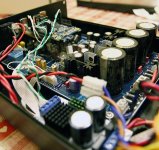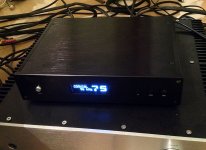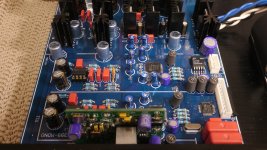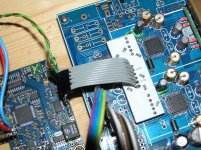Hi Luca,
Would you please be so kind to post the way you made the connection between these two boards?
I have searched all your posts here but could not find a more specific info on how to do this.
Thank you and kind regards,
Goran
I just took 2 solid AWG22 wires from I2SoverUSB spdif outputs and inserted them where Weiliang's XMOS board should be connected.
To identify the right contacts, you can use DAC's schematics attached:View attachment schematic of dual AK4399 with software control.pdf
Look in the upper middle of the schematics, to the left of AK4113 chip you can find the 7-pin USB connector where Weiliang XMOS should be connected.
Just insert spdif ground wire into pin 6 and spdif + wire into pin 5 or 7 (please choose the pin that has a small smd cap following, i can't remember if it's 5 or 7).
That's so easy.
Sorry i can't take a pic to show that better, because there is a really small room; but follows a pic of the board inside the chassis:

terranigma is using another board, Amanero, which probably outputs 24bit i2s.
Amanero is 32bit until you hadn't convert it to other formats in 16 or 24bits using its firmware config tool. I tested Dac in mode3 (24bit) and mode7 (32bit) with 32bit output i2s but I didn't notice any playback defect (I assume test done in correct way). Probably Dac truncades residual bits but I'm not sure. I'm quite newbie on such things.
Btw,
If I had I2SoverUSB, I would consider its spdif output first in this situation because spdif data is generated via firmware on first hand. This is a big advantage in my opinion. So no new MCU, no software modification and having fully functional software and display in hand.
Another thing is, shipped MCU requires spdif/coax cable intact for putting the dacs in operation. Otherwise you won't have sound even if you feed the dacs in proper way.
Direct i2s makes sense if you plan to alter MCU with Arduino like Nino and mine. I got to discard spdif receiver part completely which is not a wanted situation for me at the beginning (because its sound quality was really good) but I saw that it is not going to be so easy for me to incorporate both Amanero and AK4113 so I gave priority to Amanero.
Regards.
If I had I2SoverUSB, I would consider its spdif output first in this situation...
That's what I would do first.
Thank you terranigma.
Hi cu6apumMine is done. Spdif-only this time.
Very nice indeed! Nice display, did you use Arduino MCU and modified the code?
Nino
Last edited:
As usual I'm late to many of these DIY parties. 🙂 I recently purchased V1.1 of the AK4399 Parallel DAC board and AK4118 USB soft-control board. I also purchased this XMOS board for it too.
I know this is dumb question, but there are only 2 ways this daughter card can be fitted and the most obvious way is with the components facing the back of the DAC board. The other way makes it interfere with other components. I looked around the thread for similar pictures, but can't find any with the daughter card fitted to the DAC PCB. Can someone please inform of the correct positioning.
The reason I ask is that my computer is not recognizing the USB input and therefore I'm suspect. I also did the fool-hard thing and solder it. So if indeed it's in wrong it will take a bit more work to correct it. At the moment I intend to use the board without mods, but first I want to get the XMOS board working. I guess there's also the possibility the XMOS card is faulty.
Rick
I know this is dumb question, but there are only 2 ways this daughter card can be fitted and the most obvious way is with the components facing the back of the DAC board. The other way makes it interfere with other components. I looked around the thread for similar pictures, but can't find any with the daughter card fitted to the DAC PCB. Can someone please inform of the correct positioning.
The reason I ask is that my computer is not recognizing the USB input and therefore I'm suspect. I also did the fool-hard thing and solder it. So if indeed it's in wrong it will take a bit more work to correct it. At the moment I intend to use the board without mods, but first I want to get the XMOS board working. I guess there's also the possibility the XMOS card is faulty.
Rick
Attachments
Rick,
It looks correctly installed.
Did you use the dealer supplied xmos driver?
If not contact your dealer or pm me
It looks correctly installed.
Did you use the dealer supplied xmos driver?
If not contact your dealer or pm me
It seems now this 7-pin blue XMOS board is hard to get any more (New Xmos USB 7 Pin Asynchronous Daughter Card for AK4399 DAC7 ES9018 SN | eBay). They want to provide the newer version of XMOS U8 USB board (New Asynchronous Xmos U8 USB Module Compatible for AK4399 DAC ES9018 7pin | eBay). I tryed to install the new U8 board to Weiliang DAC V1.1 board, but cant really get it work as needed. There remains always strong crackling disturbance with signal. Drivers I used are v. 2.24, I got them here: http://diyhifishop.com/download/Weiliang_XMOS_Driver_V2.24.rar There are pretty good installation instructions included, better than with older driver versions. But it does not work really. I tryed on WinXP and Win8.1, both the same result. Does anybody have experience, are those v.2.24 drivers right for the U8 board? Or should there be used some other? Or is my U8 board just bad? Otherwise the DAC works as supposed to.
Rick,
It looks correctly installed.
Did you use the dealer supplied xmos driver?
If not contact your dealer or pm me
I believe my XMOS board is bad. Can't measure any voltages at all. I've asked my seller for another one, but do not know for sure whether he'll oblige me. The Toslink and coaxial connection both work, so I don't suspect the DAC board itself, but perhaps that may be an issue. Seems the quality control is a little lacking.It seems now this 7-pin blue XMOS board is hard to get any more (New Xmos USB 7 Pin Asynchronous Daughter Card for AK4399 DAC7 ES9018 SN | eBay). They want to provide the newer version of XMOS U8 USB board (New Asynchronous Xmos U8 USB Module Compatible for AK4399 DAC ES9018 7pin | eBay). I tryed to install the new U8 board to Weiliang DAC V1.1 board, but cant really get it work as needed. There remains always strong crackling disturbance with signal. Drivers I used are v. 2.24, I got them here: http://diyhifishop.com/download/Weiliang_XMOS_Driver_V2.24.rar There are pretty good installation instructions included, better than with older driver versions. But it does not work really. I tryed on WinXP and Win8.1, both the same result. Does anybody have experience, are those v.2.24 drivers right for the U8 board? Or should there be used some other? Or is my U8 board just bad? Otherwise the DAC works as supposed to.
Regarding the drivers... I installed 2 different ones the latest being 2.23 I believe, but understand they are specifically modified for each brand of XMOS card. My computer still does not recognize the device. I'll keep the thread up to date on my saga. 🙂
Rick
All is well now. After installing the XMOS CORRECTLY the board came to life and everything appears to be working now. Funny how that works. 🙂
All is well now. After installing the XMOS CORRECTLY the board came to life and everything appears to be working now. Funny how that works. 🙂
How does it sound? I'm looking into one of these boards too but can't decide on the version you got (available through doukmall) or the minishow0328 version.😕
It was only fixed a couple hours ago, so haven't had any time to listen. 🙂 This is also my first XMOS card, so don't have anything to compare it to. Honestly, at my age I'm losing my finer audio discriminating abilities anyway. But I love the challenge of building this stuff.How does it sound? I'm looking into one of these boards too but can't decide on the version you got (available through doukmall) or the minishow0328 version.😕
The DAC and XMOS I bought were from along;
Power amp chassis, Assembled amp board items in along1986090 store on eBay!
It is quite some time to listen this dac with external Amanero usb->i2s receiver connected. As my ears reveal the sound character of this new setup more correctly in time, it became more obvious to me that there was something missing in terms of sound quality: less dynamics and muffled trebles. Even though I have no question about Amanero's built and component (clocks,regulators, etc) quality. Thus I removed all modifications regarding to external i2s setup and I put spdif part intact again. After some listening sessions, it is quite obvious to me that I was right. Dynamics and airy presentation back again with the expense of a bit shifted noise floor.
I wasn't using any kind of i2s isolator or level shifter (Amanero is 3.3V but AK's 5V) like components between dacs and Amanero. Maybe I have to put more effort on such things when feeding the dacs with an external i2s receiver. On the other side, I have to consider that I'm using a pro sound card as spdif source which indeed have its own part on the result.
I just wanted to share my experience for those who planning to do similar things with their boards.
Regards.
I wasn't using any kind of i2s isolator or level shifter (Amanero is 3.3V but AK's 5V) like components between dacs and Amanero. Maybe I have to put more effort on such things when feeding the dacs with an external i2s receiver. On the other side, I have to consider that I'm using a pro sound card as spdif source which indeed have its own part on the result.
I just wanted to share my experience for those who planning to do similar things with their boards.
Regards.
I'm glad to report I had success solving my problem with XMOS U8 card. I found out the cause for misbehave of the card was the USB cable! The XMOS U8 card gets powered not from DAC board, but from computer thru the USB cable 5V lines. The cable I used with this board was CCA (Copper Covered Aluminum) and has resistance of 1,5 ohms per 3 m length (0,5 ohm/1m). Seems not very much, but it was somehow crucial. I installed pure copper cable made by myself and everything starts to work. You can hear the output signal distortion character with this bad cable here. If you hear something similar or get some strange error messages from Foobar, then better to start to seek problem first in cable rather than in driver or XMOS board itself. So the DAC USB cable quality seems to be quite important. It does not mean you should rush to buy those billion-priced esoteric cables, but the cable should be adequate. And maybe it could be better to route the +5V power to the XMOS board from DAC itself in future, there is +5V already coming to the XMOS board socket pin 4.
Last edited:
Hi terranigma,...
I wasn't using any kind of i2s isolator or level shifter (Amanero is 3.3V but AK's 5V) like components between dacs and Amanero. Maybe I have to put more effort on such things when feeding the dacs with an external i2s receiver. ...
The output level is not a problem I think, AK4113's output level is 3.3V too.
Maybe it has something to do with the AK4113 still powered, although PDN pin is LOW.
I don't have SQ problems on my i2s setup (I2SoverUSB), didn't notice any that is...
This weekend I'm gonna remove power to AK4113 entirely, and install my i2s-distribution-board, if that changes a lot I'll get back to you.🙂
Nino
i2s implementation
I installed my new 'i2s-distribution board' with success, eventually, see picture.
At first I had made a ribbon cable, using the GSGSGSGSG scheme, to carry the i2s signals. When I tested the DAC, the sound had become a bit dull, less bass and 3D image was gone. My previous cable was more of improvised nature (see my previous post), but it was also 2 cm shorter, and attached to the resistors of the left DAC (and thus made i2s signal path shorter for the left DAC) . The new cable was even longer (15cm), the total length of the i2s transfer (for both DACs) became too long, about 20+ cm.
So I reorganized my setup a bit and made a ribbon cable of ~5cm, and with the added track length it totals ~10 cm now. SQ has dramatically improved since, it's even better than I ever had, fantastic! 🙂
My conclusion is: For a proper i2s implementation use a cable as short as possible and distribute the signals over the two DACs with (close to) equal length. This way the dual DAC approach really pays off IMO.
Regards
Nino
I installed my new 'i2s-distribution board' with success, eventually, see picture.
At first I had made a ribbon cable, using the GSGSGSGSG scheme, to carry the i2s signals. When I tested the DAC, the sound had become a bit dull, less bass and 3D image was gone. My previous cable was more of improvised nature (see my previous post), but it was also 2 cm shorter, and attached to the resistors of the left DAC (and thus made i2s signal path shorter for the left DAC) . The new cable was even longer (15cm), the total length of the i2s transfer (for both DACs) became too long, about 20+ cm.
So I reorganized my setup a bit and made a ribbon cable of ~5cm, and with the added track length it totals ~10 cm now. SQ has dramatically improved since, it's even better than I ever had, fantastic! 🙂
My conclusion is: For a proper i2s implementation use a cable as short as possible and distribute the signals over the two DACs with (close to) equal length. This way the dual DAC approach really pays off IMO.
Regards
Nino
Attachments
Hi Nino,
Nice to see you have implemented external i2s with proper approach. Probably I just observed same dull sound as you described because of non optimized i2s connection including desperately long cables which were approximately 15 cms.
Btw, I became a bit uncertain about completely discarding spdif part because I recently discovered that I can use digital-out connectors of old cdrom drives as a complete spdif source for dac (with an additional small circuit to convert ttl level to spdif level). I tested playback quality at digital output of cdrom and I couldn't notice any quality issue by comparing cd rips of same tracks on my pc. Cdrom playback was even much more "silent" because there isn't any unwanted noise injected by my soundcard.
It would be an interesting project build a small cd player box with a cdrom controller kit from ebay.
Edit: Nino, what are you using as analog stage? I see some sort of external module next to output resistors.
Regards.
Nice to see you have implemented external i2s with proper approach. Probably I just observed same dull sound as you described because of non optimized i2s connection including desperately long cables which were approximately 15 cms.
Btw, I became a bit uncertain about completely discarding spdif part because I recently discovered that I can use digital-out connectors of old cdrom drives as a complete spdif source for dac (with an additional small circuit to convert ttl level to spdif level). I tested playback quality at digital output of cdrom and I couldn't notice any quality issue by comparing cd rips of same tracks on my pc. Cdrom playback was even much more "silent" because there isn't any unwanted noise injected by my soundcard.
It would be an interesting project build a small cd player box with a cdrom controller kit from ebay.
Edit: Nino, what are you using as analog stage? I see some sort of external module next to output resistors.
Regards.
Last edited:
Hi terranigma,
I'm using a discrete output stage, comprising of a passive filter, differential amp with FET input and FET output buffer. It has no NFB and dual mono psu. I purchased the nice PCB from Ray, he designed it to be used in the Marantz CD63 originally. I made a copper cover for it and customized the filter for using with AK4399.
Nino
I'm using a discrete output stage, comprising of a passive filter, differential amp with FET input and FET output buffer. It has no NFB and dual mono psu. I purchased the nice PCB from Ray, he designed it to be used in the Marantz CD63 originally. I made a copper cover for it and customized the filter for using with AK4399.
Nino
- Status
- Not open for further replies.
- Home
- Source & Line
- Digital Line Level
- ebay:Weiliang Dual X2 AK4399 DAC with LCD


